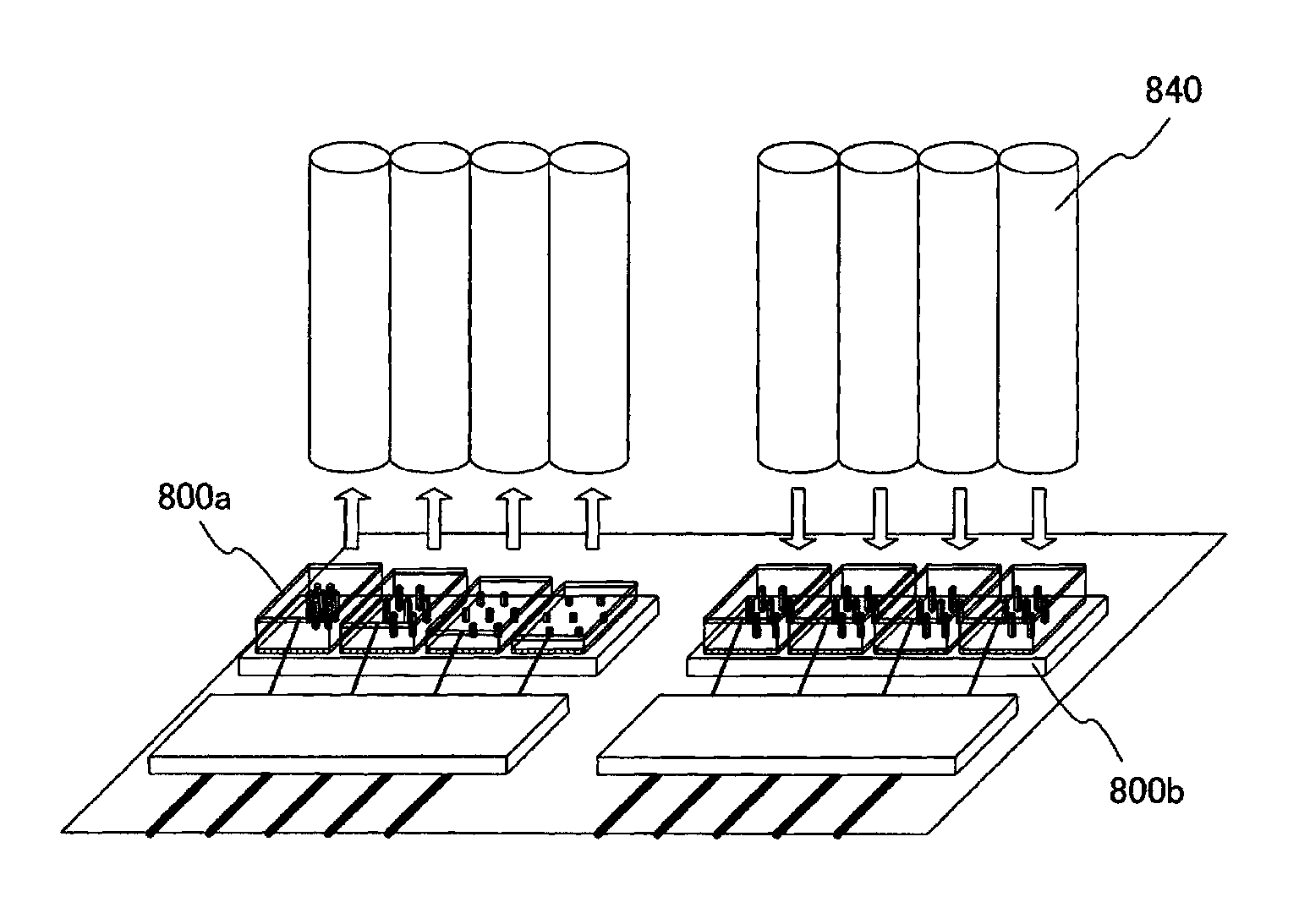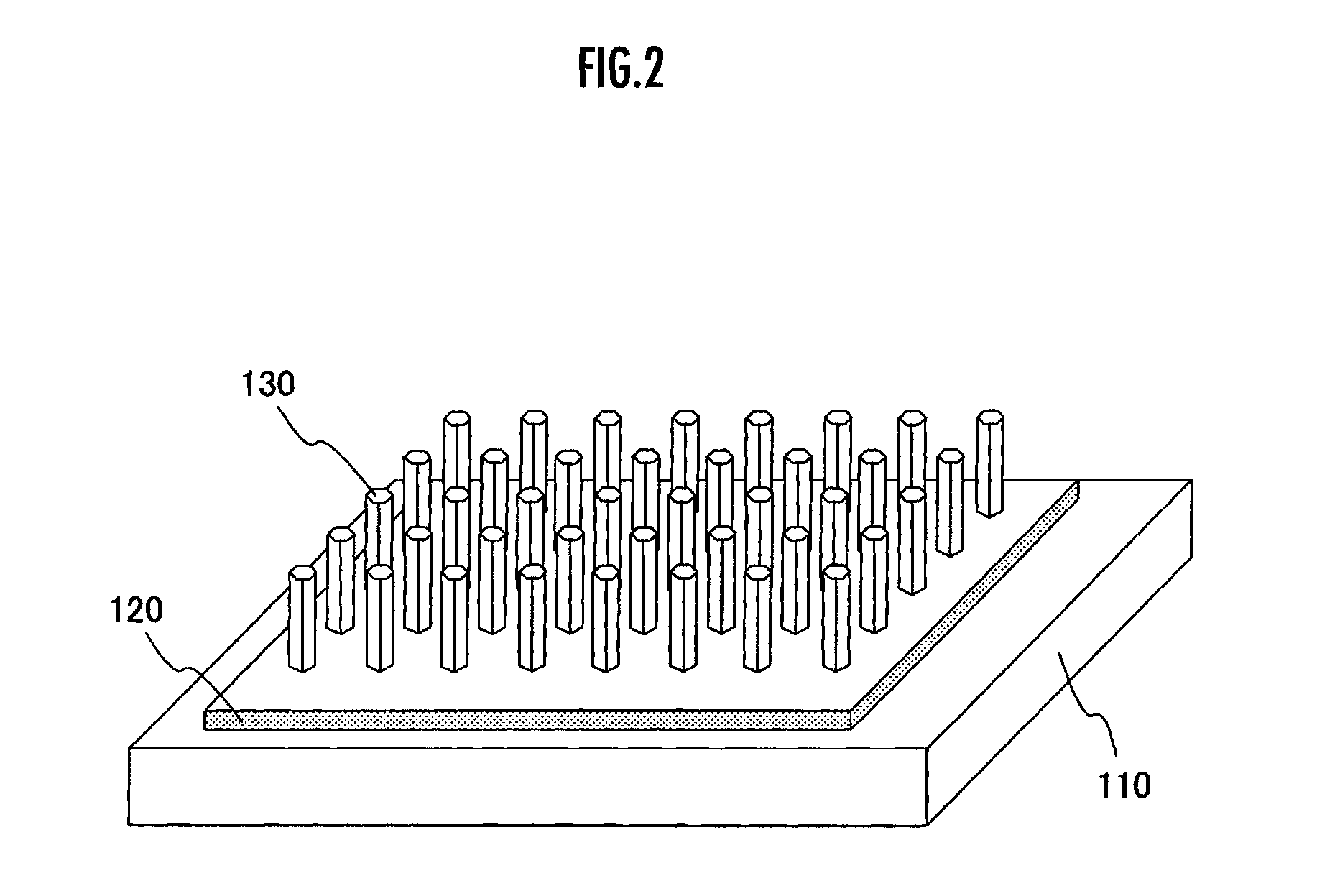Solar Cell Element, Color Sensor and Method of Manufacturing Light Emitting Element and Light Receiving Element
a technology of solar cells and light emitting elements, applied in the direction of solid-state devices, sustainable manufacturing/processing, final product manufacturing, etc., can solve the problem that conventional solar cell elements are incapable of sufficiently absorbing incident ligh
- Summary
- Abstract
- Description
- Claims
- Application Information
AI Technical Summary
Problems solved by technology
Method used
Image
Examples
first embodiment
[0159]In a first embodiment of the present invention, an example of a semiconductor nanorod array used in the solar cell element of the present invention is illustrated.
[0160]FIG. 1 is a perspective view showing the construction of the semiconductor nanorod array in the first embodiment. As shown in FIG. 1, the semiconductor nanorod array in the first embodiment has an electroconductive GaAs(111)B substrate 110, an amorphous SiO2 film 120 and semiconductor nanorods130.
[0161]A method of manufacturing the semiconductor nanorod array shown in FIG. 1 will be described.
[0162]First, the GaAs(111)B substrate 110 is cleaned and the amorphous SiO2 film 120 is formed to a thickness of about 20 nm on the surface of the GaAs(111)B substrate 110 by using an RF sputtering apparatus with a SiO2 target.
[0163]Next, a positive resist is applied on the amorphous SiO2 film 120; the GaAs(111)B substrate 110 is set in an EB drawing apparatus; and a pattern in which circular holes are arrayed in triangula...
second embodiment
[0174]In a second embodiment of the present invention, an example of a solar cell element of the present invention having a plurality of quantum well layers is illustrated.
[0175]FIG. 4 is a perspective view showing the construction of the solar cell element in the second embodiment. As shown in FIG. 4, a solar cell element 100 in the second embodiment has an electroconductive GaAs substrate 110, a silicon oxide (SiO2) film 120, semiconductor nanorods 130, a transparent embedment film 140, a transparent electrode 150, a first metal electrode 160 and a second metal electrode 170. The first electrode 160 and the second electrode 170 are connected to an external circuit.
[0176]The electroconductive GaAs substrate 110 is an electroconductive GaAs(111)B substrate.
[0177]The SiO2 film 120 covers the (111)B plane of the GaAs substrate 110. The film thickness of the SiO2 film 120 is, for example, 20 nm. In regions of the SiO2 film 120 where the semiconductor nanorods 130 are disposed, openings...
third embodiment
[0193]While in the second embodiment an example of the solar cell element of the present invention having quantum well layers is illustrated, an example of a solar cell element of the present invention further having a surface protective layer is illustrated in a third embodiment of the present invention.
[0194]The solar cell element in the third embodiment is identical in construction to the solar cell element 100 in the second embodiment shown in FIG. 4 except that the construction of the semiconductor nanorods is different. Description will therefore be made by reading a solar cell element 100′ in the third embodiment in place of the solar cell element 100 in the second element, and semiconductor nanorods 130′ in place of the semiconductor nanorods 130 in FIG. 4. The components identical to those of the solar cell element 100 in the second embodiment are indicated by the same reference numerals, and the description of the portions appearing again will not be repeated.
[0195]As show...
PUM
 Login to View More
Login to View More Abstract
Description
Claims
Application Information
 Login to View More
Login to View More - R&D
- Intellectual Property
- Life Sciences
- Materials
- Tech Scout
- Unparalleled Data Quality
- Higher Quality Content
- 60% Fewer Hallucinations
Browse by: Latest US Patents, China's latest patents, Technical Efficacy Thesaurus, Application Domain, Technology Topic, Popular Technical Reports.
© 2025 PatSnap. All rights reserved.Legal|Privacy policy|Modern Slavery Act Transparency Statement|Sitemap|About US| Contact US: help@patsnap.com



